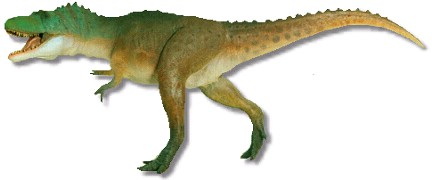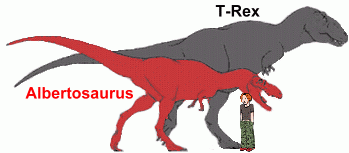  Albertosaurus was a large, meat-eating dinosaur, and a close relative of the T-rex. It lived during the late Cretaceous period, somewhere around
Albertosaurus was a large, meat-eating dinosaur, and a close relative of the T-rex. It lived during the late Cretaceous period, somewhere around Albertosaurus was smaller than T- rex and lived a few million years earlier. Many Albertosaurus fossils have been found in Canada in the province of Alberta, as well as in the western USA. 
The Albertosaurus walked on two legs, and like the T-rex, had a large head with many sharp teeth. Its long tail likely provided balance, and enabled it to make quick turns when chasing its prey. Albertosaurus was about 9 metres long, and weighed somewhere around 2500 kg on average. It may have been able to run at speeds of up to 40 km/h for short distances. Recent discoveries of fossils of these giant meat-eaters indicate that they probably lived in packs, hunting together over the then tropical Alberta landscape. Because their sharp, curved teeth were good for biting, not chewing, Albertosaurus probably swallowed chunks of meat whole. Like the T-rex, Albertosaurus had two-fingered short front arms ... not much larger than human arms. The function of these front arms is not known; they are too short to have been used for feeding, and were not strong enough for defense. Since the first discovery in 1884, fossils of more than 30 individuals have been recovered, providing scientists with a more detailed knowledge of Albertosaurus anatomy than is available for most other tyrannosaurids. The discovery of twenty-six sets of remains at one site provides evidence of pack behaviour, and allows studies which are impossible with lesser-known dinosaurs due to their remains being rarer and more fragmentary compared to those of Albertosaurus. The name Albertosaurus (meaning "Alberta lizard") was given to this dinosaur in 1905, following the first discovery of fossils by Joseph Burr Tyrrell in 1884 in western Canada. Visit the Royal Tyrell Museum. |